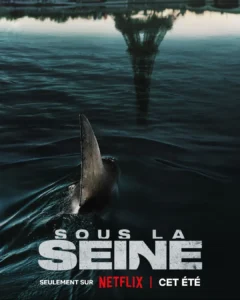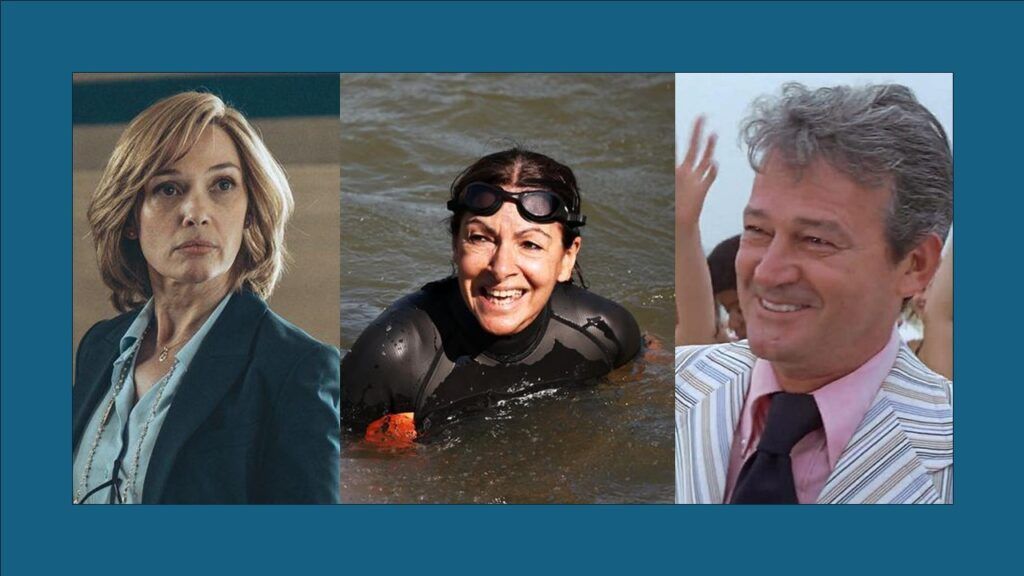In this guest post, Venus Bivar and Roxanne Panchasi reflect on the recent Netflix film ‘Sous la Seine’ in the context of the recent Paris Olympics and the ongoing climate emergency
This past June, as France braced itself for a set of high-stakes snap legislative elections on the eve of the Paris Summer Olympics, Netflix released a new disaster film about a shark who wreaks a different kind of havoc in the French capital. The summer sleeper-hit Sous la Seine (Under the Seine) has two female leads who we first meet in the Great Pacific Garbage Patch where a group of French scientists are documenting the existential threat posed to marine life by both industrial pollution and climate change. Sophia, the film’s human protagonist, is a committed marine biologist whose team is tracking and studying Lilith, a shark aptly named for the female figure of chaos and rebellion from Jewish mythology. When this more-than-human protagonist unexpectedly attacks and kills several members of Sophia’s crew (including her husband), she returns to Paris utterly traumatized.

Three years later, Sophia is approached by Mika, a “Save our Seas” activist who, along with the rest of her tech-savvy collective, tries to protect sharks from their human predators by turning off their tracking devices. Mika has discovered that Lilith has somehow made her way from Hawaii to Paris. Enlisting Sophia’s help to guide Lilith out of the Seine and back to the ocean, Mika hopes to save the shark from the certain death she will meet if the authorities get to her first. Already intimately familiar with the danger Lilith represents, Sophia instead teams up with the film’s aspirational version of the Paris Police, a racially diverse, good-looking, noble force whose members go out of their way to help the city’s unhoused population. They soon realize they are dealing with a whole new species of shark that has adapted in terrifying ways: doubling in size every three months, Lilith and her exclusively female offspring (that reach maturity by the tender age of two months) reproduce via parthenogenesis (no mate required). The film is thin on the details of how all this could happen, but anyone with an understanding of exponential growth can see that this might pose a problem for just about every other species on earth.
More locally and urgently, Lilith and her babies could turn an upcoming triathlon in the Seine into a feeding frenzy. Warned by Sophia and the police, the female mayor of Paris is the film’s metaphorical shark, styled in a sharp pantsuit and power bob. Recalling Larry Vaughn, the infamous Amity Island mayor from Jaws (1975), she refuses to call off the event. Too much money, too much prestige, and too much power is at stake. This is the very same test that political and financial leaders continue to fail. Faced with environmental and other human-provoked crises, the bureaucrats and profit-mongers take a business-as-usual approach, banking on their ability to clean up after the fact. Or not.

Given the film’s setting and narrative arc, and the timing of its release, Sous la Seine just begged to be read as a cultural premonition and cathartic fantasy of the Paris Olympics. While the idea of a shark infestation in the City of Light seems highly improbable, so too did the $1.4 billion plan to clean up the river in time for the swimming competitions of the 2024 Games. The colossal project became a farce in the lead up to the event as President Emmanuel Macron and Paris Mayor Anne Hidalgo pledged to swim in the depolluted Seine, while a growing number of French people in turn pledged to defecate in the river in protest against the massive spending associated with hosting the games (#JeChieDansLaSeine). At a moment of heightened social and economic inequality, the French government seemed to be literally throwing money into the river, greenwashing their extravagances with talk of improving the environment. Despite Hidalgo’s brief dip in the apparently cleaned river on July 17, the Seine’s safety remained uncertain after the games began on July 26th.
Humanity is currently facing an ecological crisis of existential magnitude. Over a thousand people died from the heat during this year’s pilgrimage to Mecca; almost half a million Brazilians were displaced and two hundred died in catastrophic flooding this past spring; and in May wet-bulb temperatures in India came perilously close to the 35-degree threshold. And yet, governments and companies the world over are rolling back their decarbonisation targets. In short, humans with the power to do something about this existential threat are refusing to adapt. The logic that led the French state to spend billions on preparing for the games rather than meeting the needs of its citizens is the very same logic that prompts world leaders to approve new plans for fossil fuel extraction. The possibility of accruing profits in the short-term blinds those in power to long-term human and planetary needs.
Sous la Seine is a disaster film for the Anthropocene, the term we have devised to demarcate an era in the Earth’s history in which human impact is no longer simply biological, but rather geological. Lilith is no errant shark who has wandered into a lagoon looking for a snack. She and her babies were created by human negligence, and the death and destruction they bring to Paris is entirely human made. The traditional man vs. nature narratives, in which we are humbled by the god-like force of natural disaster, no longer hold. Humankind is the natural disaster and Mother Earth–here in the form of big (female) shark energy–has come to take her revenge.
There is, therefore, something deeply satisfying about how the film ends: a wide shot of central Paris, with much of the city submerged under water as shark fins circle Sophia and Adil, the sole police officer who survives the bloodbath. Hundreds of people have either been devoured by Lilith and her all-girl shiver or trampled by other humans in their attempts to flee the carnage. There will be no after-the-fact, no opportunity to clean up following the mayor’s calculated decision. It is far too late for media spin and damage control.
What sets Lilith apart from other horror-movie predators is that we’re on her side. Like the thousands of people around the world who have joined “Team Orca” in solidarity with killer whales colliding with and downing vessels off the coasts of Spain and Portugal during the past couple of years, the viewer of Sous la Seine is invited over and again to cheer on Team Lilith. Granted, it’s hard to imagine a future that ends well for Lilith and her kind. With those reproduction rates, they’re bound to hit a Malthusian ceiling sooner rather than later. But for the ninety-minute run of the film, you can’t help but want the sharks to win.
—-
Venus Bivar is Associate Professor of Environmental History at the University of Oxford. Her research interests lie at the intersection of economic history and the environment, and in particular she is interested in the extraction of natural resources, industrial pollution, and economic growth. She is the author of Organic Resistance: The Struggle Over Industrial Farming in Postwar France and iscurrently writing a book on the environmental consequences of the rise of petrochemicals in postwar Marseille.
Roxanne Panchasi is Associate Professor of History at Simon Fraser University. Her teaching, research, and writing focus on modern France and empire, nuclear culture, popular music, and the history of the end of the world. She is the author of Future Tense: The Culture of Anticipation in France Between the Wars (Cornell University Press, 2009), and the founding host of New Books in French Studies, a podcast channel on the New Books Network.


